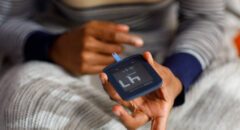
According to the Centers for Disease Control and Prevention, almost 40 million Americans are living with diabetes. That number includes an alarming number of Black Americans as well. If you’re one of those diagnosed with the condition, there are 5 essential areas you need to have covered every day to ensure you’re healthy.
1. Follow Your Meal Plan
A key part of managing diabetes is making sure to eat the right amount of the right foods at the right time. That might sound complicated but the right meal plan is high in fiber, whole grains, nonstarchy vegetables, and fruits.
It’s best to avoid refined carbohydrates, added sugars, unhealthy fats, high levels of salt, and processed foods. It’s also important that you eat at around the same time of the day and never skip any meals. If you use insulin, make sure to take your shot before eating.
2. Check Your Blood Sugar Levels
As someone with diabetes, it will be integral to check our blood sugar levels multiple times throughout the day. It’s a surefire way to know what’s going on in your body since your levels will change when you eat, take your medicine, or exercise.
It’s best to work with your doctor to determine the ideal times for checking your blood sugar levels, what your readings should be, and how to use your blood sugar meter effectively.
Doctors recommend writing down your readings so you can show your doctor how your levels change over time. It can also be helpful to use a diabetes app that automatically sends these readings to your doctor.
RELATED: 4 Helpful Tips For Children Living With Diabetes
3. Take Your Medication
Depending on the type of diabetes you have and your overall health, you may need to take different medications every day. These are necessary to maintain the right blood sugar levels.
You should never skip your medication or change the dosage without your doctor’s permission. If you suspect that the medication is not as effective as it was before, talk to your doctor immediately.
When administering an insulin shot, it’s best to avoid areas that have scars or stretch marks. The outside of your upper arms or thighs as well as your waist are great places to use instead.
4. Check Your Feet
Unfortunately, diabetes can damage your nerves and make it hard for you to feel pain. This loss of sensation may affect the feet more than anywhere else and make it hard for you to tell if you have cuts, blisters, or sores that need to be addressed.
However, checking your feet every day can help. Using a mirror, check for any changes in your feet and see your doctor immediately if anything looks different. It’s not always possible to take care of the problem on your own.
RELATED: The Fitness Triad: 3 Keys To Living Well With Diabetes
5. Get Some Exercise
The World Health Organization (WHO) recommends getting at least 30 minutes of moderate physical activity every day. Being active can help with maintaining a healthy weight, lowering your bad cholesterol levels, and lowering your blood sugar levels.
Possible options include walking, jogging, and swimming but there are no limits to what you can do to stay active. If you have physical limitations or have been mostly sedentary, talk to your doctor about which exercise routines might be best for you.
When To See A Doctor
The good thing about following a program is that you’re more likely to spot when things are going wrong. Some of the issues that you need to bring to your doctor’s attention include having high blood sugar at the same time each day and having low blood sugar consistently. You should also go to the emergency room immediately if you have symptoms such as headaches, nausea, dizziness, drowsiness, and rapid breathing.
It may seem like there are a lot of steps involved in managing your diabetes but it helps to have a daily plan in place. If you’re experiencing new symptoms or signs that the scheduled maintenance checks aren’t working, it’s time to see your doctor. Poorly managed diabetes can cause a lot of other health complications that you need to avoid.








